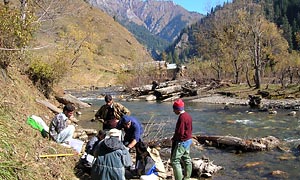Big moves by a little fish: characterizing movement patterns of the endangered rio grande silvery minnow in a fragmented river
Date:
2019 - 2022
Abstract:
The Rio Grande Silvery Minnow (Hybognathus amarus, RGSM), has experienced a dramatic 95% reduction in its historical range. The overall goal of this study is to document and better understand the movement ecology and patterns of RGSM, and specifically address whether they currently have the ability to move long distances in either direction. We used Passive Integrated Transponder (PIT) tags in stocked RGSM with stationary and mobile PIT-tag antenna systems to detect and track movement patterns across time and space. To date, we have released six batches of PIT-tagged RGSM, totaling over 28,000 fish. Of those, 13,610 have been detected at least once, an extremely high resight rate (47%). The mean distance moved by PIT-tagged RGSM was 10.6 km, and the maximum distance moved was 142.9 km. Surprisingly, a total of 80 individuals passed upstream through the San Acacia Dam. The large proportion of fish which remain just downstream of the dam long after release may indicate they are attempting to move and disperse upstream. Our data to date suggest RGSM are highly mobile, with the ability to make targeted long distance movements both upstream (to the extent possible) and downstream. As indicated by repeated detections over time, this study design has been very successful, despite the small size of tagged fish and their hatchery origin. Direct evidence of RGSM movement patterns may provide crucial insights that could help target recovery efforts and ultimately aid in meeting management goals.
Funding:
- U.S. Bureau of Reclamation Upper Colorado Basin - Albuquerque Area Office
- U.S. Geological Survey – Utah Cooperative Fish and Wildlife Unit (in-kind)
- The Ecology Center at Utah State University
Investigators:
- Martinique J. Chavez, Dept. of Watershed Sciences, USU
- Dr. Phaedra Budy, Dept. of Watershed Sciences, USU
- Peter MacKinnon, Biomark Inc. & Dept. of Watershed Sciences, USU
- Dr. Casey Pennock, Dept. of Watershed Sciences
Other Collaborators:
- Dr. Mark McKinstry, Bureau of Reclamation
- Michael Volmer, Bureau of Reclamation
- Eric Gonzales, Bureau of Reclamation
- Thomas Archdeacon, U.S. Fish and Wildlife Service
- Gary Thiede, Dept. of Watershed Sciences

Using mobile raft-mounted antenna to detect PIT-tagged Rio Grande Silvery Minnow in the San Acacia Reach of the Middle Rio Grande. Photo Credit: Gary Thiede.


